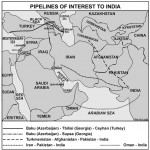It is not that only India and Pakistan have problems. India and Bangladesh have some issues to settle. Same is the case with Nepal and Bhutan. Pakistan and Afghanistan also do not lag behind on this score. Therefore, the Bhutanese Prime Minister Lyonchhen Jigmi Thinley made a lot of sense when in his inaugural speech at the 16th SAARC summit he pointed out how the bloc was “losing focus” because of prevailing tensions between the member states. “Fractious and quarrelsome neighbours do not make a prosperous community”, he stressed, watched by leaders from India, Pakistan, Sri Lanka, Nepal, Afghanistan, Bangladesh and Nepal.
We must allow the SAARC to develop slowly. Do not expect miracles ““ common currency, common security, SAARC parliament, visa-free travel ““ from it in near future.
With a SAARC identity or South Asian solidarity being largely part of political rhetoric, SAARC’s role has been greatly diminished and the annual summits provide just a platform for talks among its leaders and photo opportunities. In fact, the media – at least this is the case with Indian media – focuses more on bilateral talks between the leaders on the sidelines of the summit than on the deliberations on SAARC matters. For instance, at Thimpu, the meeting between Indian Prime Minister Manmohan Singh and his Pakistani counterpart Yusuf Raza Gilani drew the most attention of the assembled journalists.
SAARC’s failure to bloom as a powerful regional body could be attributed to a single factor – each member state’s national interest. Every member wants to get as much as possible from SAARC, if there is any, but share with other SAARC members as little as possible. There is no South Asian ideological bond that unites the people of eight countries.
The diehard supporters of the SAARC miss no opportunity to cite the success stories of Association of South East Asian Nations (Asean) and the European Union (EU). But they miss the point that neither the Asean nor the EU has such disparities among its members as these are within the SAARC. Neither the EU nor the Asean has a giant like India within it which is superior in every respect to its neighbours.
Then there is the common security perception. The fear of China brought the Asean countries together in 1970s. And the fear of the then Soviet Union made the then European Coal and Steel Community and the European Economic Community, the predecessors of the EU, possible. But here in South Asia, while India has always chalked out a course of autonomy in its interactions with the rest of the world, other SAARC members have been guided at different times differently by the United States and China. In fact, most of these countries have resented the prominence of India most of the times.
This is not to suggest that the SAARC is not a useful organization. Despite all its limitations, in the last few years, particularly since the 14th Summit in New Delhi in April 2007, SAARC has begun to lay the institutional framework for regional cooperation. Regional institutions, in the form of the South Asian Regional Standards Organization (SARSO) in Dhaka, the SAARC Arbitration Council in Islamabad, the SAARC Development Fund (SDF) in Thimphu, the South Asian University (SAU) in New Delhi, among others, are the building blocks of regional development.
We must allow the SAARC to develop slowly. Do not expect miracles – common currency, common security, SAARC parliament, visa-free travel – from it in near future.




